
Acer negundo, the box elder, boxelder maple, Manitoba maple or ash-leaved maple, is a species of maple native to North America. It is a fast-growing, short-lived tree with opposite, compound leaves. It is sometimes considered a weedy or invasive species, and has been introduced to and naturalized throughout much of the world, including in South America, Australia, New Zealand, South Africa, much of Europe, and parts of Asia.

Campanula is the type genus of the Campanulaceae family of flowering plants. Campanula are commonly known as bellflowers and take both their common and scientific names from the bell-shaped flowers—campanula is Latin for "little bell".

The family Campanulaceae, of the order Asterales, contains nearly 2400 species in 84 genera of herbaceous plants, shrubs, and rarely small trees, often with milky sap. Among them are several familiar garden plants belonging to the genera Campanula (bellflower), Lobelia, and Platycodon (balloonflower). Campanula rapunculus and Codonopsis lanceolata are eaten as vegetables. Lobelia inflata, L. siphilitica and L. tupa and others have been used as medicinal plants. Campanula rapunculoides may be a troublesome weed, particularly in gardens, while Legousia spp. may occur in arable fields.

Persicaria pensylvanica is a species of flowering plant in the buckwheat family, Polygonaceae. It is native to parts of North America, where it is widespread in Canada and the United States. It has also been noted as an introduced species in parts of Europe and South America. Common names include Pennsylvania smartweed and pinkweed.

Uvularia is a genus of flowering plants in the family Colchicaceae, which is closely related to the lily family (Liliaceae). They are commonly called bellworts, bellflowers, or merrybells. The genus name is derived from the Latin ūvula meaning "little grape", likely because of the way the flowers hang downward. For the same reason Uvularia may also refer to the similarly derived palatine uvula, which hangs down from the soft palate in the mouth. The plants are often found growing on wooded slopes or in ravines and they spread by stolons, or stoloniferous rhizomes. The plants are usually 45–60 cm (18–24 in) in height and bear one or two flowers per stem in April and May, that hang downward from the axils of the leaves.

Triodanis is a genus of flowering plants within the family Campanulaceae, native to North and South America. Venus' looking-glass is a common name for plants in this genus.
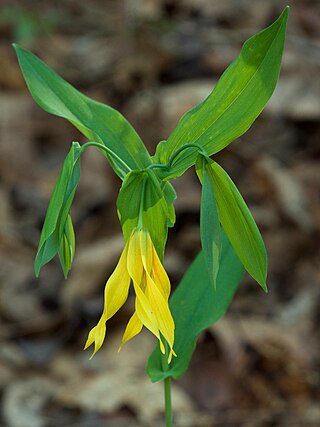
Uvularia grandiflora, the large-flowered bellwort or merrybells, is a species of flowering plant in the family Colchicaceae, native to eastern and central North America.

Eurybia macrophylla, commonly known as the bigleaf aster, large-leaved aster, largeleaf aster or bigleaf wood aster, is an herbaceous perennial in the family Asteraceae that was formerly treated in the genus Aster. It is native to eastern North America, with a range extending from eastern and central Canada through the northeastern deciduous and mixed forests of New England and the Great Lakes region and south along the Appalachians as far as the northeastern corner of Georgia, and west as far as Minnesota, Missouri and Arkansas. The flowers appear in the late summer to early fall and show ray florets that are usually either a deep lavender or violet, but sometimes white, and disc florets that are cream-coloured or light yellow, becoming purple as they mature. It is one of the parent species of the hybrid Eurybia × herveyi.

Campanula latifolia, the giant bellflower, is a species of bellflower in the family Campanulaceae. It is also known as the large campanula and the wide-leaved bellflower. It is native to Europe and western Asia and is widely grown as an ornamental plant.
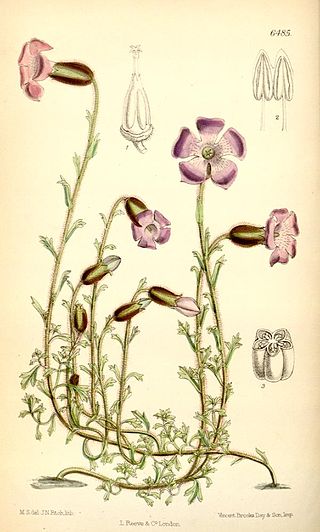
Cyananthus lobatus, commonly known as the lobed-leaved cyananth or trailing bellflower, is an ornamental flowering plant of the family Campanulaceae.
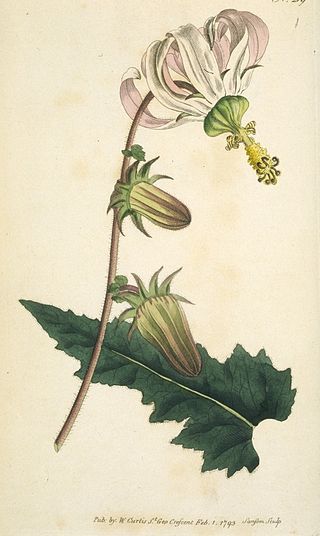
Michauxia campanuloides, the rough-leaved michauxia, is an ornamental plant in the Campanulaceae (bellflower) family. It is native to Greece, Turkey, Syria, Lebanon, Palestine, Israel.

Symphyotrichum ericoides, known as white heath aster, frost aster, or heath aster, is a species of flowering plant in the family Asteraceae native to much of central and eastern North America. It has been introduced to parts of Europe and western Asia.

Campanula rapunculoides, known by the common names creeping bellflower, rampion bellflower, rover bellflower, garden bluebell, creeping bluebell, purple bell, garden harebell, and creeping campanula, is a perennial herbaceous plant of the genus Campanula, belonging to the family Campanulaceae. Native to central and southern Europe and west Asia, in some parts of North America it is an extremely invasive species.
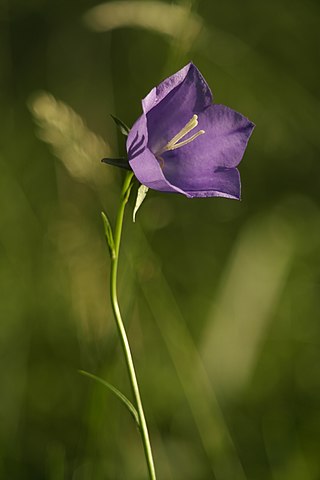
Campanula persicifolia, the peach-leaved bellflower, is a flowering plant species in the family Campanulaceae. It is an herbaceous perennial growing to 1 m. Its flowers are cup-shaped and can be either lilac-blue or white. Its foliage is narrow and glossy with a bright green appearance.
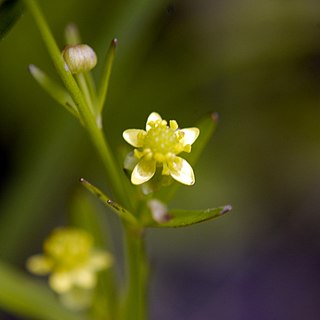
Ranunculus abortivus is a species of flowering plant in the buttercup family, Ranunculaceae. Its common names include littleleaf buttercup, small-flower crowfoot, small-flowered buttercup, and kidneyleaf buttercup. It is widespread across much of North America, found in all ten Canadian provinces as well as Yukon and the Northwest Territories, and most of the United States, except Hawaii, Oregon, California, and parts of the Southwest.

Hesperocodon hederaceus, synonym Wahlenbergia hederacea, also known as the ivy-leaved bellflower, is a species of flowering plant that is found throughout Europe. It is the only species in the genus Hesperocodon. The delicate, patch-forming, hairless perennial herb has thin, creeping stems about 20 cm in length. Its pale green leaves are long-stalked and have an ivy-shaped, rounded structure. These leaves can be described as having a cordate shape and are approximately 5–12 mm long and wide. The plant has erect, solitary, pale blue flowers in summer and autumn, with bell-shaped corolla with 5 short lobes. The flowers are 6–10 mm long x 5–8 mm wide and sit on fine stalks 1–4 cm long. It is suggested that the long pedicels are an adaptation to assist in seed dispersal.

Solidago rigida, known by the common names stiff goldenrod and stiff-leaved goldenrod, is a North American plant species in the family Asteraceae. It has a widespread distribution in Canada and the United States, where it is found primarily east of the Rocky Mountains. It is typically found in open, dry areas associated with calcareous or sandy soil. Habitats include prairies, savannas, and glades.

Triodanis leptocarpa, commonly called slimpod Venus' looking-glass, is a species of flowering plant in the bellflower family (Campanulaceae). It is native to the United States, where it is found primarily in the Great Plains and Midwest. Its natural habitat is in dry upland prairies and open rock outcrops. It is tolerant of disturbance and can be found in pastures and roadsides.




















